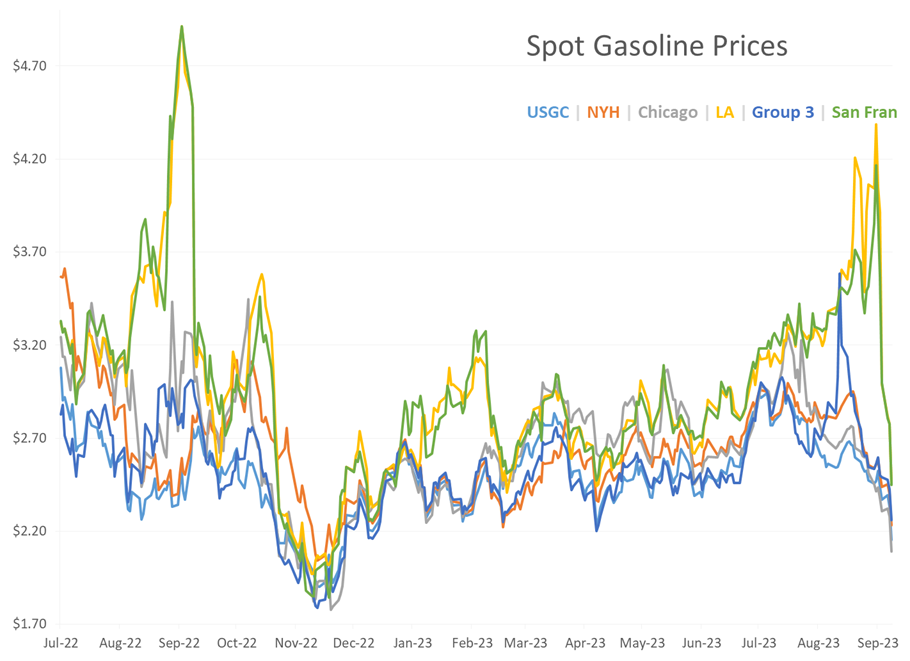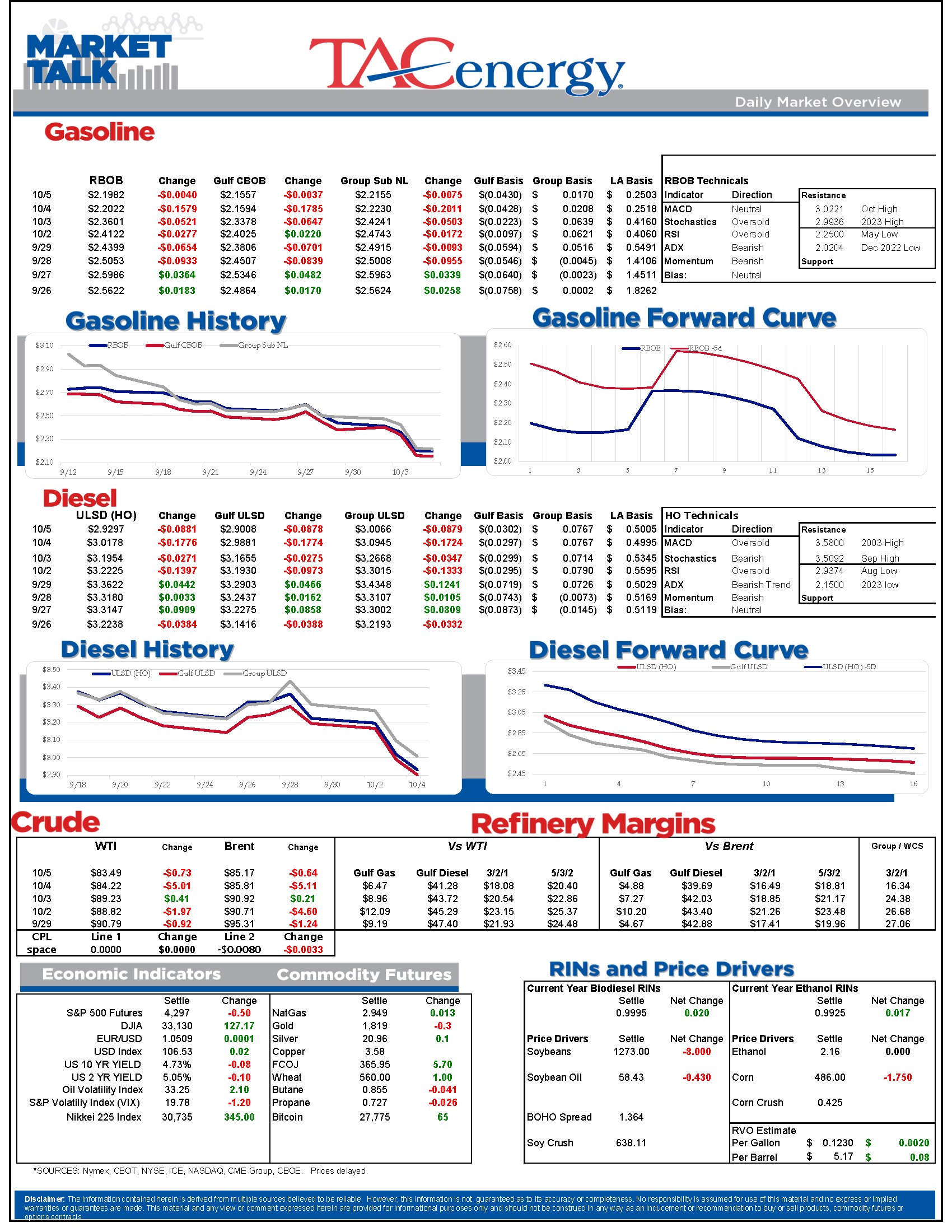The Big Increase In Gasoline Stocks Pushes Total US Inventories Above The Seasonal 5-Year Range

The meltdown continues for oil and diesel prices this morning after Wednesday’s big sell-off that saw refined products drop by 15-17 cents/gallon, and oil have its biggest drop of the year over $5/barrel.
At the time of this writing, ULSD prices are down close to 40 cents for the week, with 8 cent losses in the early going, after barely blinking at technical support near the $3 mark. Longer term charts suggest that if prices hold below $3, there’s a chance we go back to the $2.50 range, but we’re overdue for a bounce after this big move.
Headlines continue to pin the blame for this week’s heavy selling on “demand fears” since there is little on the supply side of the equation to point to with Russia and Saudi Arabia confirming they will hold their output cuts through the end of the year despite the recent recovery in prices, while US inventories continue to hold at low levels. There certainly seems to be a risk-off feel to the selling as equity and bond markets have also seen investors heading for the exits this week, just as it appears some hedge funds are doing in energy contracts.
The DOE’s weekly report showed the extent of a busy fall refinery maintenance schedule, which several predict will see the most capacity taken offline since 2019. That drop in run rates didn’t prevent a big increase in gasoline stocks however, as a dismal demand figure that had some people wondering if we’re once again in the early stages of a consumer pullback, and others questioning the DOE’s calculations.
The big increase in gasoline stocks pushes total US inventories above the seasonal 5-year range for the first time since the war in Ukraine broke out 19 months ago.
While RBOB futures are hovering around breakeven so far today, this week’s plunge puts wholesale gasoline prices in a few spot markets at the lowest levels of the year so far, which is currently offering huge margins for retailers, and will soon be passed along to consumers at the pump as long as we don’t see a quick reversal. A WSJ article this morning suggests that declining margins on in-store sales and other inflationary items are pushing retailers to keep fuel margins higher than in previous years, while also noting the cost increase associated with the renewable fuel standard, but overlooking the LCFS and Cap & Trade costs on the West Coast.
How exciting(!): The EIA invites you to join them for a watch party to see the release of their 2023-2024 Winter Fuels outlook on 10/16. Last year’s report was notable for predicting a colder winter and higher heating costs, and was completely wrong in essentially all regards.
Meanwhile, Russia is ironically nervous about heating costs after using the energy weapon on Europe the past two years, issuing new price regulations to keep heating fuel prices in check and to head off any more uprisings.
Another possible item adding to the negative sentiment in refined products this week: Reports that the Dangote refinery in Nigeria, pegged as a “game changer” if it actually works, has started crude runs for the first time after years of delays.
News & Views
View All
Energy Futures Are Caught Up In Headline Tug-O-War This Morning
Energy futures are caught up in headline tug-o-war this morning with Canadian oil production concerns and a positive US GDP report trying to push prices higher while sinking Chinese demand worries and Gaza ceasefire hopes are applying downward pressure. The latter two seem to be favored more so far this morning with WTI and Brent crude oil futures down ~45 cents per barrel, while gasoline and diesel prices are down about half a cent and two cents, respectively.
No news is good news? Chicago gasoline prices dropped nearly 30 cents yesterday, despite there not being any update on Exxon’s Joliet refinery after further damage was discovered Wednesday. Its tough to say if traders have realized the supply situation isn’t as bad as originally thought or if this historically volatile market is just being itself (aka ‘Chicago being Chicago’).
The rain isn’t letting up along the Texas Gulf Coast today and is forecasted to carry on through the weekend. While much of the greater Houston area is under flood watch, only two refineries are within the (more serious) flood warning area: Marathon’s Galveston Bay and Valero’s Texas City refineries. However, notification that more work is needed at Phillip’s 66 Borger refinery (up in the panhandle) is the only filing we’ve seen come through the TECQ, so far.
Premiums over the tariff on Colonial’s Line 1 (aka linespace value) returned to zero yesterday, and actually traded in the negatives, after its extended run of positive values atypical of this time of year. Line 1’s counterpart, Line 2, which carries distillates from Houston to Greensboro NC, has traded at a discount so far this year, due to the healthy, if not over-, supply of diesel along the eastern seaboard.
Click here to download a PDF of today's TACenergy Market Talk.

WTI And Brent Crude Oil Futures Are Trading ~$1.50 Per Barrel Lower In Pre-Market Trading
The across-the-board drawdown in national energy stockpiles, as reported by the Department of Energy yesterday, stoked bullish sentiment Wednesday and prompt month gasoline, diesel, and crude oil futures published gains on the day. Those gains are being given back this morning.
The surprise rate cut by the People’s Bank of China is being blamed for the selling we are seeing in energy markets this morning. While the interest rate drop in both short- and medium-term loans won’t likely affect energy prices outright, the concern lies in the overall economic health of the world’s second largest economy and crude oil consumer. Prompt month WTI and Brent crude oil futures are trading ~$1.50 per barrel lower in pre-market trading, gasoline and diesel are following suit, shaving off .0400-.0450 per gallon.
Chicagoland RBOB has maintained its 60-cent premium over New York prices through this morning and shows no sign of coming down any time soon. Quite the opposite in fact: the storm damage, which knocked Exxon Mobil’s Joliet refinery offline on 7/15, seems to be more extensive than initially thought, potentially extending the repair time and pushing back the expected return date.
There are three main refineries that feed the Chicago market, the impact from one of them shutting down abruptly can be seen in the charts derived from aforementioned data published by the DOE. Refinery throughput in PADD 2 dropped 183,000 barrels per day, driving gasoline stockpiles in the area down to a new 5-year seasonal low.
While it seems all is quiet on the Atlantic front (for now), America’s Refineryland is forecasted to receive non-stop rain and thunderstorms for the next four days. While it may not be as dramatic as a hurricane, flooding and power outages can shut down refineries, and cities for that matter, all the same, as we learned from Beryl.


